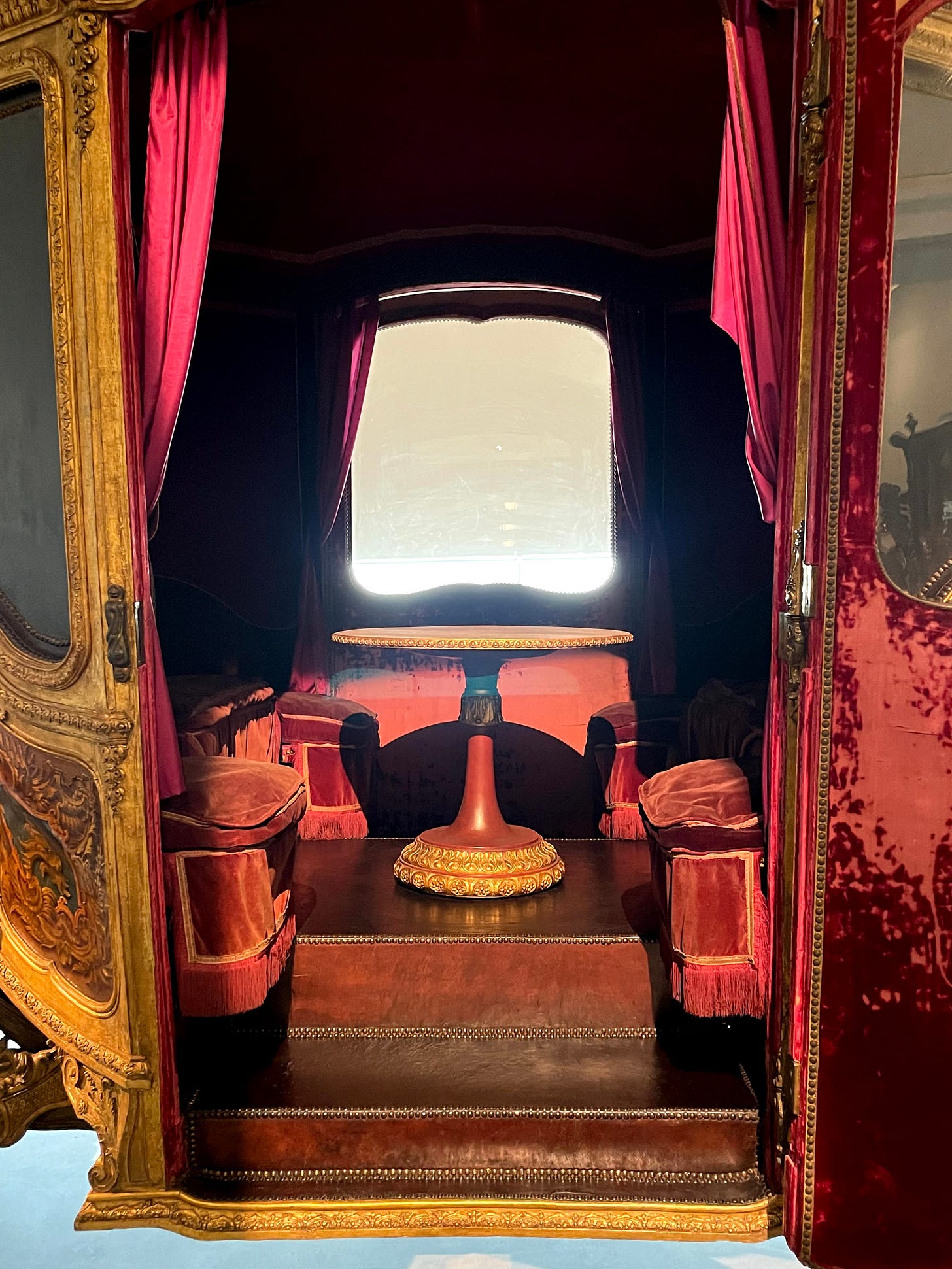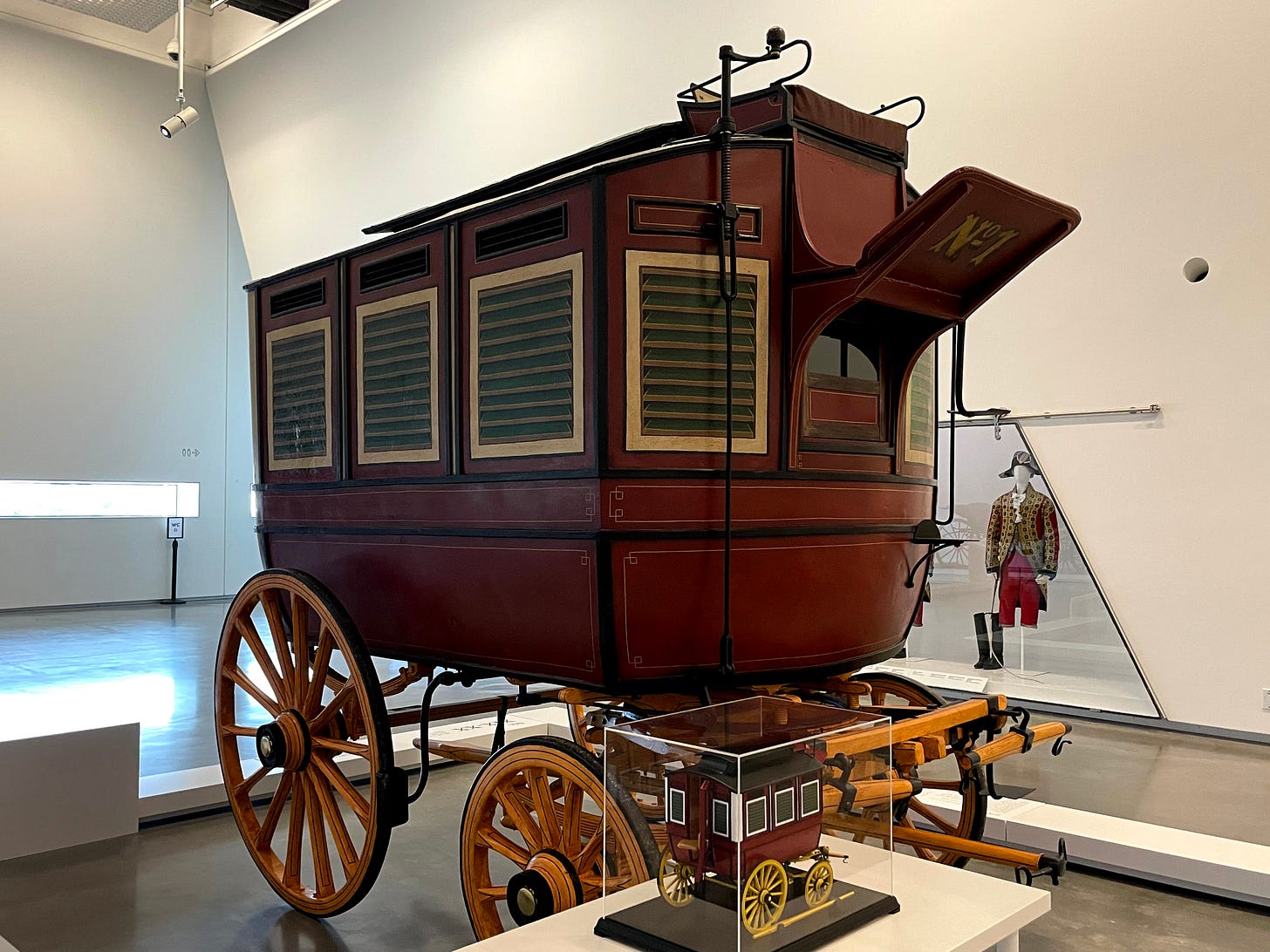We returned to Belém last Wednesday. During our first trip, the National Coach Museum had not yet opened. Since it typically is the top-ranked thing to do in Belém we figured it was worth a trip.
Great Building
The museum is directly across the street from the Belém train station … a short 25-minute ride from Cascais. The building itself is a large white and glass modern box which to my way of thinking was the perfect complement to what we found inside. The admission is typically 8€, though again we benefited from the 50% senior discount. We boarded a large elevator, I assume sized to permit the coaches to be moved in and out of the facility, and rose to the first floor. The first coach we saw was the oldest in the collection.
Nagging Question
This coach was used by King Filipe II of Portugal (a.k.a King Filip III of Spain) in 1619 when he came into Lisbon to meet his court assembly. You may recall learning about King Filipe during our tale of King Sebastian. Anyway, I noticed that there are glass panes (windows) suspended by straps and covered in black leather hanging from the roof of the coach. I thought about the practicality of glass windows riding over the gutted dirt roads and cobblestones.
As I walked on further, I realized that most of the coaches had glass windows and they were now fixed/fitted into the sides of the coaches. I realize I should have been marveling at the sculptures, gold leaf, and intricate paintings on every coach. But instead, all I could think about was why didn’t the glass break?
Oddly enough, as you move through the exhibit (listening to chamber music) they explain the different suspension systems that were implemented to improve the comfort of the passengers. Many using only leather straps must have offered a jarring ride. I actually came home and Googled various forms of “why didn’t glass windows break in 18th-century carriages”. I found the following after many, many attempts:
When glass is deflected, it has one face under compression and the other in tension. Whilst the resistance of glass to compressive stress is extremely high, its resistance to tensile stress is significantly lower.
The resistance to breakage on deflection is in the order of:
- 40 MPa (N/mm2) for annealed glass
- 120 to 200 MPa for toughened glass (depending on thickness, edgework, holes, notches etc).
The increased strength of SGG SECURIT toughened glass is the result of the toughening process putting both faces under high compression. SAINT-GOBAIN GLASS can advise on appropriate working stresses for different glass types and can calculate suitable thicknesses for any architectural application.
Unfortunately, I was a religion major more familiar with Hebrew and Aramaic than science speak. I also Facetimed with a friend in San Francisco that has a brother-in-law that just knows stuff like this. I await her research.
A Much Earlier RV
There are placards with interesting information written about nearly every coach. As I read about folding beds and tables like the one above, I recalled our trip to the RV/MH Hall of Fame in Indiana some years earlier. Somehow the 1900’s models I saw in Elkton didn’t hold a candle to these 1600-1800 models.
The coaches are displayed in chronological order from oldest to newest. The one pictured above was manufactured in 1854 and was used to move mail and travelers. The trip from Lisbon to Porto took 34 hours and included 23 stops to allow passengers to rest and horses to be changed. Its service was suspended when the railroad came online.
Another interesting coach is the one you see pictured above. It was used to transport prisoners. A film showed the restoration of the metal coach which has faux windows and 6 cells inside. Weighing 2 tons, this is the oldest horse-drawn prisoner transport vehicle in Portugal.
After spending 90 minutes in the museum I can understand why it makes everyone’s list of things to do in Belém. And as the Thai Sala is in the adjoining park, Jerónimos Monastery and the Discovery Monument are within the next two blocks and Pastéis de Belém is just a 5-minute walk away, it is well worth the trip.
Of course, you will have to come back on Friday to learn about the best pastel de nata I have ever eaten. And if you think you can answer my glass question in a way a liberal arts major can understand, please leave a comment.









Imagine the number of artisans needed to work on one coach. These are definitely works of art. The engineering answer for the glass issue needs to be dusted off the shelf in my gray matter. Thank you for a wonder article among so many great journal entries. Have a wonderful day.
I can’t answer the glass question—but, I do find these coaches fascinating. Thanks for sharing…so interesting.